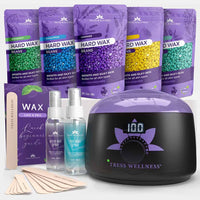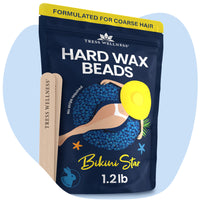Ah, Brazilian waxing—the secret to smooth, hair-free skin that leaves you feeling confident and ready for anything. But how long can you expect those silky results to last? Let's dive into the world of Brazilian waxing and explore the factors that influence the duration of your post-waxing smoothness.
How Long Does Brazilian Wax Last
The short answer is a Brazilian wax can last you for a solid 4 weeks. This obviously depends on your hair growth. But on average a good Brazilian wax lasts a few weeks to a month if you know how to do a brazilian wax in sections.
What Affects Your Hair Growth and Post-Waxing Results:
- Hair Growth Cycle: Your hair growth cycle plays a significant role in determining how long your Brazilian wax will last. Hair grows in different phases, including the anagen (growth) phase, catagen (transitional) phase, and telogen (resting) phase. Since waxing removes hair from the root, it typically lasts longer than shaving, but individual hair growth cycles vary.
- Skin Type and Sensitivity: Your skin's unique characteristics play a significant role in post-waxing outcomes. Those with faster hair growth or heightened skin sensitivity may experience regrowth sooner than others. Additionally, individuals with dry or dehydrated skin may notice accelerated regrowth due to compromised barrier function.
- Hair Thickness and Density: The thickness and density of your hair follicles contribute to the durability of your waxing results. Coarser, denser hair tends to have deeper roots and longer anagen phases, resulting in prolonged smoothness after waxing. Conversely, finer hair may regrow more quickly, necessitating more frequent waxing sessions.
Does Regular Waxing Slow Down Hair Growth and Volume?
Yes, regular waxing can gradually reduce hair growth and volume over time. By consistently removing hair from the root, you may notice that your hair grows back finer and sparser with each waxing session. While waxing doesn't permanently stop hair growth, it can lead to longer-lasting results and softer regrowth compared to other hair removal methods like shaving.
Does At-Home Brazilian Waxing Affect Results Differently?
Whether you wax at home or wax at the salon, your Brazilian wax will last you the same number of days. While salon professionals boast expertise and precision, at-home waxing offers convenience and cost-effectiveness. If you have the right tools and know the right techniques you can get a salon-grade waxing at home.

The Tress Wellness All-In-One Waxing kit helps you replicate salon-like Brazilian waxing results at home. It comes with a wax warmer, premium quality hard wax beads, pre and after-waxing spray, spatulas and at-home waxing guide. With this, you can get long-lasting results when you do your Brazilian waxing at home!
Make sure to check out our Complete Guide on Brazilian Waxing before you get started!
What Wax Should You Use to Make Brazilian Waxing Last Longer?
When it comes to long-lasting smoothness, hard wax wins for Brazilian waxing. Unlike soft wax, which sticks to both hair and skin, hard wax sticks only to the hair, minimizing discomfort and reducing the risk of skin irritation.
Tress Wellness hard wax beads are formulated with premium ingredients for gentle yet effective hair removal, ensuring extended intervals between waxing sessions. For sensitive areas like the bikini line and Brazilian waxing, Tress Wellness's Bikini Star beads are perfect. This is gentle on your skin down South while being tough on the coarse hair.
How to Make Brazilian Waxing Last Longer:
Everyone wants smooth Brazilian waxing results to last them for longer. There are ways to do that. You can do a few things to lock in that smoothness for weeks. Post-waxing care can help with that
- Exfoliate Regularly: Exfoliating your skin a few days before your waxing appointment can help remove dead skin cells and prevent ingrown hair, allowing for smoother and longer-lasting results. Choose gentle exfoliants containing alpha hydroxy acids (AHAs) or beta hydroxy acids (BHAs) to prevent irritation and promote cell turnover.
- Moisturize Daily: Keep your skin hydrated and moisturized between waxing sessions to maintain its smoothness and prevent dryness, which can lead to faster regrowth. Emollient-rich moisturizers containing ingredients like hyaluronic acid and ceramides lock in moisture, preventing dryness and prolonging the interval between waxing sessions.
- Avoid Sun Exposure: Direct sun exposure can stimulate hair growth and lead to faster regrowth after waxing. Protect your skin with sunscreen and avoid prolonged sun exposure to prolong the results of your Brazilian wax. Opt for SPF-infused moisturizers or sunscreens with an SPF of 50 or higher for protection.
Frequently Asked Questions about Brazilian Waxing Hair Growth:
How Long Does Brazilian Waxing Last?
On average, Brazilian waxing results can last anywhere from three to six weeks, depending on individual factors such as hair growth cycle, skin type, and hair thickness.
How Often Should I Get a Brazilian Wax?
It's recommended to schedule Brazilian waxing appointments every four to six weeks to maintain smooth, hair-free skin.
Does Brazilian Waxing Hurt Less Over Time?
With regular waxing, many individuals find that the discomfort lessens over time as the hair grows back finer and sparser.
Can I Shave Between Brazilian Waxing Appointments?
While it's best to avoid shaving between waxing sessions. Ingrown hair and red bumps come when you shave between Brazilian waxing sessions. To maintain consistent results, you can trim any regrowth with scissors if needed.
There you have it—the lowdown on how long Brazilian waxing lasts and tips for extending the smoothness between appointments. Armed with this knowledge, you can confidently embrace Brazilian waxing as a long-lasting hair removal solution. Have more questions? Feel free to share this blog and spread the word about the benefits of Brazilian waxing!




